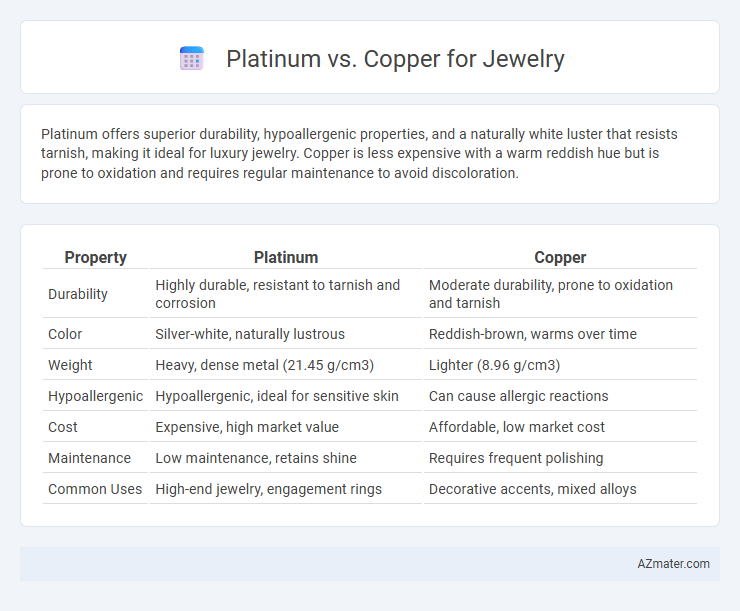Platinum offers superior durability, hypoallergenic properties, and a naturally white luster that resists tarnish, making it ideal for luxury jewelry. Copper is less expensive with a warm reddish hue but is prone to oxidation and requires regular maintenance to avoid discoloration.
Table of Comparison
| Property | Platinum | Copper |
|---|---|---|
| Durability | Highly durable, resistant to tarnish and corrosion | Moderate durability, prone to oxidation and tarnish |
| Color | Silver-white, naturally lustrous | Reddish-brown, warms over time |
| Weight | Heavy, dense metal (21.45 g/cm3) | Lighter (8.96 g/cm3) |
| Hypoallergenic | Hypoallergenic, ideal for sensitive skin | Can cause allergic reactions |
| Cost | Expensive, high market value | Affordable, low market cost |
| Maintenance | Low maintenance, retains shine | Requires frequent polishing |
| Common Uses | High-end jewelry, engagement rings | Decorative accents, mixed alloys |
Introduction to Platinum and Copper in Jewelry
Platinum and copper are distinct metals commonly used in jewelry, each offering unique benefits and aesthetic qualities. Platinum is a rare, dense, and hypoallergenic metal known for its durability, natural white sheen, and resistance to tarnish, making it ideal for heirloom-quality pieces such as engagement rings and fine jewelry. Copper, valued for its warm reddish hue and affordability, is often used in costume jewelry and as an alloying metal to strengthen gold and silver, though it is prone to oxidation and requires maintenance to retain its appearance.
Physical Properties: Platinum vs Copper
Platinum exhibits a higher density and greater hardness than copper, making it more durable and resistant to scratches in jewelry applications. Copper has excellent malleability but is softer and prone to tarnishing over time, requiring more maintenance. The superior corrosion resistance and hypoallergenic nature of platinum contribute to its preference in high-end, long-lasting jewelry designs.
Durability and Longevity Comparison
Platinum offers superior durability compared to copper due to its higher resistance to tarnish, corrosion, and scratches, making it ideal for long-lasting jewelry pieces. Copper, although attractive with its warm reddish hue, is softer and prone to oxidation, requiring frequent maintenance to preserve its appearance. For longevity, platinum jewelry retains its structural integrity and shine over decades, whereas copper often develops a patina and can wear down more quickly with daily use.
Hypoallergenic Qualities: Which Is Safer?
Platinum is widely regarded as safer for individuals with sensitive skin due to its hypoallergenic properties and resistance to tarnish and corrosion. Copper, while beautiful and affordable, often causes allergic reactions because it frequently contains nickel and other alloys that can irritate the skin. Choosing platinum jewelry significantly reduces the risk of skin irritation and allergic responses, making it a superior option for hypoallergenic needs.
Aesthetic Appeal and Color Differences
Platinum jewelry features a naturally white-silver sheen that enhances gemstone brilliance and maintains its color over time without tarnishing, offering a sleek, modern aesthetic. Copper displays a warm, reddish-orange hue that deepens with age, creating a unique, vintage charm but is prone to oxidation and color changes. The distinct color differences between platinum's cool, bright tone and copper's rich, warm finish influence their appeal in various jewelry styles and personal taste preferences.
Price and Value Considerations
Platinum jewelry generally commands a higher price than copper due to its rarity, durability, and hypoallergenic properties, making it a preferred choice for long-term investment and luxury pieces. Copper, being more affordable and malleable, is often used in fashion or costume jewelry but lacks the intrinsic value and resistance to tarnish that platinum offers. Consumers seeking lasting value and premium quality tend to invest in platinum, whereas copper appeals to budget-conscious buyers prioritizing trendy designs.
Maintenance and Care Requirements
Platinum jewelry requires less frequent polishing due to its naturally tarnish-resistant properties, making maintenance easier compared to copper, which oxidizes and develops a patina over time. Copper jewelry demands regular cleaning with specialized solutions to prevent discoloration and maintain its shine. Both metals benefit from gentle handling and storage away from moisture and chemicals to prolong their luster and durability.
Popular Jewelry Types for Each Metal
Platinum is highly favored for engagement rings and wedding bands due to its durability, hypoallergenic properties, and brilliant white luster that maintains its shine over time. Copper is commonly used in costume jewelry, artisan bracelets, and bohemian-style rings, appreciated for its warm reddish hue and affordability. Popular jewelry types made from copper often feature intricate designs and patina finishes, while platinum pieces emphasize timeless elegance and resilience.
Environmental and Ethical Aspects
Platinum jewelry offers superior environmental benefits due to its high recyclability and longer-lasting durability, reducing the need for frequent replacement compared to copper. Copper mining and refining often involve higher environmental degradation and energy consumption, while platinum is typically sourced from more regulated and ethical mining operations. Ethical considerations favor platinum as it is less likely to be associated with conflict minerals and supports more stringent labor and environmental standards.
Choosing the Right Metal for Your Style
Platinum offers exceptional durability and a naturally white sheen that resists tarnish, ideal for those seeking a long-lasting, hypoallergenic option. Copper provides a warm, reddish hue with affordability and unique aging characteristics, perfect for vintage-inspired or rustic jewelry styles. Selecting between platinum and copper depends on your preference for maintenance, color, and whether you prioritize luxury or budget-conscious elegance.

Infographic: Platinum vs Copper for Jewelry
 azmater.com
azmater.com